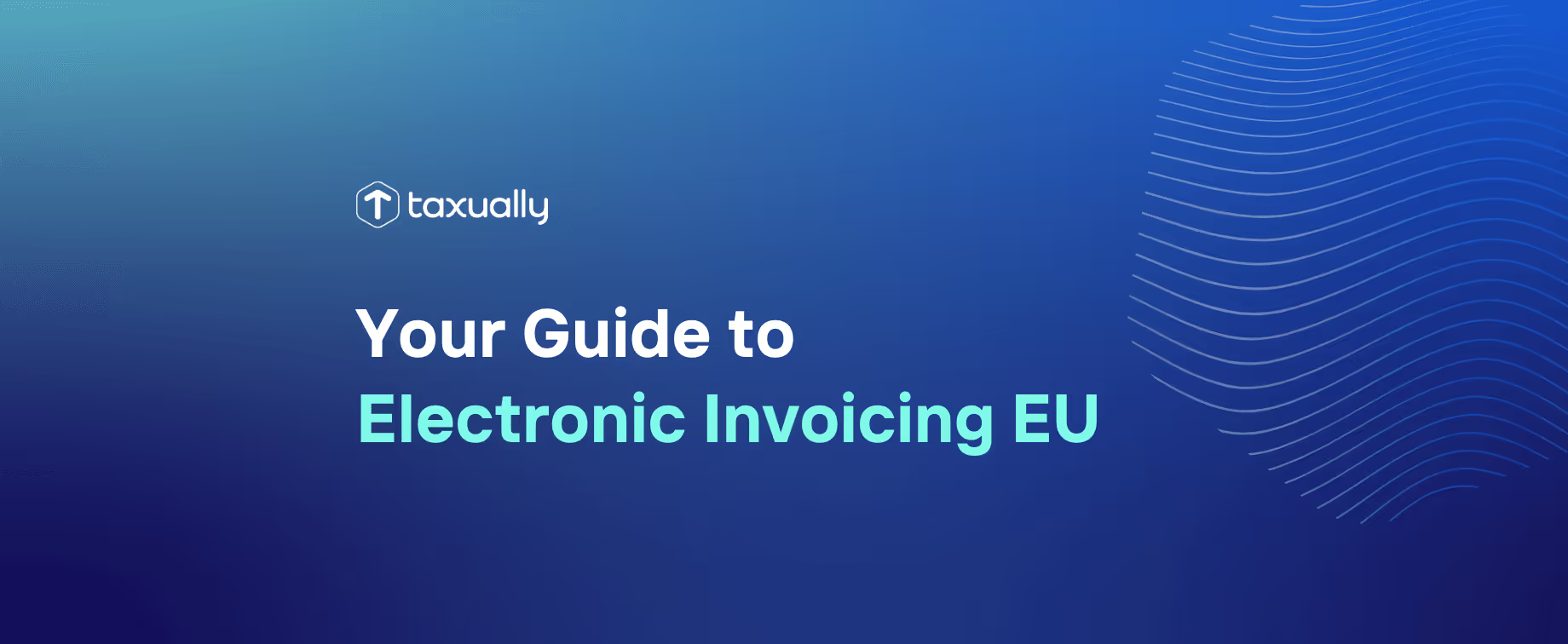Key takeaways
- E-invoicing becomes mandatory across the EU by 2028, driven by the VAT in the Digital Age (ViDA) initiative and supported by standardized formats like EN 16931 and PEPPOL.
- Benefits include faster payments, cost savings, and greater accuracy, with automated systems reducing manual errors and improving efficiency.
- Compliance requires secure storage, recipient consent, and adherence to EU legal standards, including eIDAS and national regulations.
In today's digital age, businesses across the European Union (EU) are transitioning from traditional paper-based invoicing to electronic invoicing (e-invoicing). This shift offers numerous benefits, such as increased efficiency, reduced environmental impact, and faster payment processing.
As electronic invoices become more prevalent, it's essential for businesses to understand the process and its legal framework within the EU. This comprehensive guide will take you through the ins and outs of electronic invoicing in the EU, its benefits, legal framework, and how businesses can transition to e-invoicing seamlessly.
Understanding electronic invoices
Electronic invoicing refers to the exchange of invoices in a structured electronic format rather than traditional paper-based invoices. E-invoices can be transmitted, received, and processed electronically, streamlining the entire invoicing process from creation to payment. The EU has recognized the advantages of e-invoicing and has taken significant steps to promote its adoption. In fact, both B2B and B2C businesses will be required to issue electronic invoices from 2028 as part of the EU's VAT in the Digital Age (ViDA) initiative.
E-invoicing formats
Electronic invoicing involves the electronic transmission of invoice data between trading partners. Unlike traditional paper invoices, e-invoices are in digital format, usually structured according to specific standards that allow for automated processing. In the EU, the most commonly used e-invoicing formats are based on the European standard called the European Norm (EN) or Universal Business Language (UBL).
E-invoicing can be performed through various means, including:
EDI (Electronic Data Interchange): EDI is a long-established method where invoices are sent and received in a standardized format through dedicated networks or Value-Added Networks (VANs).
XML (Extensible Markup Language): XML-based e-invoicing relies on structured data, making it easily readable by both humans and machines.
PDF/A3 (Portable Document Format): While not as structured as XML, PDF invoices with embedded data can still be processed electronically.
Web Forms: Some companies offer online platforms or web portals where users can create and send e-invoices.
PEPPOL (Pan-European Public Procurement Online): PEPPOL is a network that facilitates cross-border e-invoicing within the EU through a standardized format.
Benefits of electronic invoicing

The adoption of e-invoicing in the EU brings numerous advantages to businesses, governments, and society as a whole:
Efficiency: E-invoicing significantly reduces the time and effort required to process and manage invoices. Automated systems can handle tasks like data entry, validation, and reconciliation, minimizing the chances of errors and speeding up the payment cycle.
Cost savings: By eliminating the need for printing, postage, and manual handling of paper invoices, businesses can save substantial costs associated with traditional invoicing methods.
Faster payments: E-invoicing allows for faster delivery and processing, leading to quicker payment collection, which, in turn, improves cash flow for businesses.
Environmental impact: Transitioning to e-invoicing promotes sustainability by reducing paper usage and carbon emissions associated with the transportation of physical invoices.
Increased accuracy: Automated data entry reduces the risk of manual errors, ensuring that invoices contain accurate information, and leading to better record-keeping.
Real-time tracking: E-invoicing systems often provide real-time tracking and status updates, allowing businesses to monitor the progress of their invoices and take necessary actions promptly.
Enhanced security: E-invoicing platforms employ robust security measures to protect sensitive financial data, reducing the risk of invoice fraud and unauthorized access.
The legal framework for e-invoicing in the EU
To foster the widespread adoption of e-invoicing, the European Union has implemented legal frameworks and initiatives to support electronic invoicing practices across member states. The key regulations include:
Directive 2014/55/EU: This directive aims to establish a European standard for e-invoicing in public procurement. It requires public authorities and entities in the EU to receive and process e-invoices compliant with the European Norm (EN).
eIDAS Regulation: The Electronic Identification, Authentication, and Trust Services (eIDAS) Regulation provides a legal framework for electronic transactions, including e-invoicing, ensuring their legal validity and recognition across borders.
VAT Directive (2006/112/EC): The VAT Directive establishes the legal framework for Value Added Tax (VAT) in the EU, including provisions for the use and acceptance of e-invoices for VAT purposes.
PEPPOL (Pan-European Public Procurement Online): PEPPOL is a network and interoperability framework that facilitates the cross-border exchange of e-invoices and other e-procurement documents.
National Legislation: Each EU member state may have specific laws and regulations related to electronic invoicing, so businesses must familiarize themselves with the requirements of the countries they operate in.
Electronic invoice compliance
To ensure compliance with the legal framework, businesses must adhere to the following requirements:
Legibility and authenticity: E-invoices must be legible and guarantee the authenticity of the origin, integrity of content, and readability of data throughout the invoicing period.
Consent of the recipient: Before sending e-invoices, businesses must obtain the recipient's consent to receive electronic invoices. This consent can be explicit or implied, depending on the national regulations of each EU member state.
Storage requirements: E-invoices should be stored securely and made available for tax authorities or other relevant parties for auditing purposes. The storage period may vary depending on digital reporting requirements under the national legislation.
Data privacy: Businesses must comply with the General Data Protection Regulation (GDPR) and ensure that personal data included in e-invoices is processed lawfully and protected adequately.
Implementing e-invoicing in your business

Transitioning to e-invoicing can be a game-changer for your business, but it requires careful planning and implementation. Here are some steps to help you get started:
1. Research and choose the right e-invoicing solution
Conduct thorough research to identify an e-invoicing solution that aligns with your business needs and complies with the EU's legal requirements. Consider factors like compatibility with your existing accounting software, ease of use, security features, and scalability.
2. Obtain recipient consent
Before you submit electronic invoices to your customers, ensure that you have their explicit or implied consent to receive e-invoices. Remember to keep records of this consent in case of future audits.
3. Test and train
Before fully implementing e-invoicing, conduct testing to ensure that the system works smoothly and integrates well with your existing processes. Train your staff on using the e-invoicing platform efficiently to avoid any disruptions during the transition.
4. Ensure data integrity and security
Implement robust security measures to safeguard the integrity and confidentiality of your tax data and e-invoices. Encryption, authentication, and access controls are crucial aspects of data security.
5. Comply with legal requirements
Make sure your e-invoices comply with the EN 16931 standard and any additional regulations specific to your business sector and EU member state.
6. Monitor and evaluate
After implementing e-invoicing, closely monitor the process to identify any issues or areas for improvement. Regularly evaluate the benefits and cost savings achieved through e-invoicing and continually optimize your invoicing practices.
Conclusion
Electronic invoicing presents a transformative opportunity for businesses in the EU to enhance efficiency, reduce costs, and contribute to environmental sustainability. With the legal framework and standardization in place, adopting e-invoicing has become more accessible than ever.
By carefully planning the transition and choosing the right e-invoicing solution, businesses can take advantage of the numerous benefits and gain a competitive edge in the digital landscape of the European Union.
Do you need help with your VAT compliance? Book a free call with one of our VAT experts to find bespoke solutions for your business, optimize your VAT costs, and reach millions of new potential customers.
Frequently asked questions
New Year's Day - 1/1/2024Memorial Day - 5/27/20244th of July - 7/4/2024Labor Day - 9/2/2024Thanksgiving Day - 11/28/2024Day after Thanksgiving - 11/29/2024Christmas Eve - 12/24/2024Christmas Day - 12/25/2024
What is electronic invoicing in the EU?
E-invoicing refers to the process of generating, sending, receiving, and processing invoices in a digital format, rather than using traditional paper-based methods.
In the European Union (EU), e-invoicing is part of the broader initiative to streamline and modernize financial processes for businesses and public administrations.
Is electronic invoicing mandatory in the European Union?
The EU has been promoting and encouraging the adoption of e-invoicing to improve efficiency and reduce administrative burdens. E-invoices will become mandatory for B2C and B2B businesses in the EU from 2028.
Which EU countries have implemented e-invoicing regulations?
Some of the countries that have taken steps toward e-invoicing implementation include Italy, Spain, France, Portugal, and Germany. Each country will have its specific requirements and timelines for compliance so it's essential to consult their official government websites for the latest information on e-invoicing regulations.
Does the UK have a similar digital system?
Yes. HMRC introduced Making Tax Digital for VAT in 2019 for all eligible VAT registered UK businesses. HMRC does not require business to issue electronic VAT invoices, though.



















